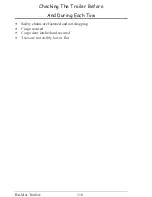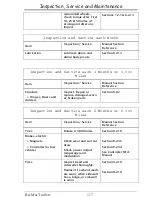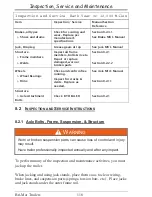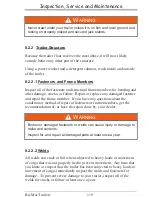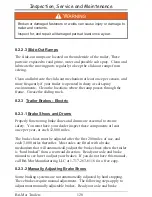
Inspection, Service and Maintenance
Bri-Mar
124
•
Fill the master cylinder with fluid as described above. Loosen the
four break-away mounting bolts enough to keep the break-away
locks from restricting the lever motion. Rotate the break-away lever
forward using small strokes until the bubbling stops inside the master
cylinder.
•
Install a bleeder hose on the bleeder screw of the farthest wheel
cylinder from the actuator. If the trailer has tandem axles, bleed the
rear axle first. Submerse the other end of the hose in a glass container
of brake fluid, so that air bubbles can be observed.
•
Open the bleeder screw and have your assistant stroke (but not
release) the break-away lever. Brake fluid and/or air bubbles will
flow into the jar. Close the bleeder screw. The helper can then allow
the breakaway lever to return to its rest position.
Repeat the process until no more bubbles are released with the stroke.
Air trapped in the brake lines will greatly reduce your braking efficiency.
Be sure to close the bleeder screw securely when the cylinder is fully
bled. Repeat the bleeding operation at each wheel cylinder. During the
bleeding process, replenish the master cylinder reservoir with fresh brake
fluid so that the level does not fall below half full. This will ensure that
no air is drawn into the system.
After all brakes have been bled, refill the master cylinder reservoir to
three-quarters full before operating. Retighten the four bolts using a
torque wrench to 90-120 inch-pounds of torque. Screw the filler cap
back into position and replace the cylinder cover. The filler cap only
needs to be finger tight.
Use only fresh brake fluid from a sealed container. DO NOT reuse fluid.
After filling and bleeding, refill the actuator. Failure to maintain an
adequate fluid level may cause brake failure.
Trailers
Summary of Contents for DT508LP
Page 144: ...Electrical Drawings Bri Mar 138 Trailers...
Page 145: ...Bri Mar 139 9 ELECTRICAL DRAWINGS Trailers...
Page 146: ...Bri Mar 140 Trailers...

